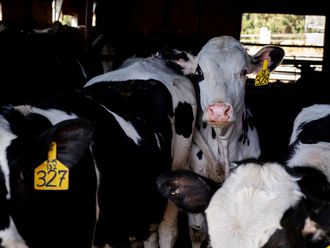
Mexico City: Hurricane Karl strengthened in the southern Gulf of Mexico late on Thursday and was expected to intensify as it crossed Mexico's offshore gas and oil terrain before making landfall late on Friday.
Karl strengthened to a Category 2 storm late on Thursday and "could reach the coast as an intense category three hurricane," the National Hurricane Centre said in a statement.
State-run oil giant Pemex evacuated platforms in the path of the storm and halted production at 14 minor wells, the company said in a statement that did not detail how those measures would disrupt production.
"Since yesterday, as a precaution, we began evacuating platforms in the area and that operation is complete," Pemex said.
The company is monitoring Karl's progress across the Bay of Campeche in the Gulf, where the bulk of Mexico's 2.55 million barrels per day of oil is produced. Two of Mexico's main oil exporting ports closed as Karl passed through the region.
Upgrade
The storm was upgraded from a Category 1 hurricane, the weakest on the five-step Saffir-Simpson scale, and achieved winds of 160 kilometres per hour, as it picked up strength as it left Mexico's main cluster of oil platforms behind and barrelled toward the state of Veracruz, where it was expected to touch land last night.
But Karl seemed unlikely to inflict lasting damage and oil prices fell more than 2 per cent as traders set aside the storm and focused on the expected resumption of a major Canadian pipeline.
The storm is the sixth hurricane of the 2010 Atlantic season. Of those, four have been "major" hurricanes that reach Category 3 or higher. At 11pm Eastern Daylight Time (0300 GMT), Karl was about 185 kilometres east of Veracruz.
Pemex suspended small craft shipping to platforms in the bay but there were no reports of damage to any oil installations there, a company employee said.
Storms in the Bay of Campeche have the potential to cause serious disruption to Mexican oil output but rarely pass far enough south to cause problems. Mexico was the No. 3 supplier of crude to the United States during the first half of this year, according to the US Energy Information Administration.
Any disruption in production would likely last days, although rare direct hits on major platforms in the past have forced lengthy shutdowns.
Yucatan Peninsula
Earlier in the week, Karl dumped rain and brought strong winds to the Yucatan Peninsula and hundreds of people, mostly Mayan villagers, were evacuated, authorities said.
The storm also knocked out power to tens of thousands of people throughout the mainly rural area. Majahual, home to a large cruise ship port, bore the brunt of the storm as it made landfall but no serious damage was reported. Cancun, a top beach destination for US and European tourists, was untouched by the storm.
Forecasters shifted the anticipated landfall of Karl south of the gasoline-importing city of Tuxpan toward Veracruz, a major Mexican port but one which does not handle any crude oil exports.
Two other hurricanes, Igor and Julia, churned across the Atlantic Ocean but posed no immediate threat to the US mainland or energy interests. Both are projected to die out far from land.
Igor was 1,350 kilometres south-southeast of Bermuda with maximum sustained winds of 205 kilometres per hour on Thursday afternoon, having weakened to a still-dangerous Category 3 storm.












